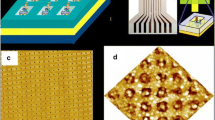Abstract
Due to the high surface area and good bio-compatibility of nano structured ZnO, it finds good utility in biosensor applications. In this work we have fabricated highly dense ZnO nano bundles with the assistance of self assembled poly methylsilisesquoxane (PMSSQ) matrix which has been realized in a carpet like configuration with implanted ZnO nano-seeds. Such high aspect ratio structures (∼50) with carpet like layout have been realized for the first time using solution chemistry. Nanoparticles of PMMSQ are mixed with a nano-assembler Poly-propylene glycol (PPG) and Zinc Oxide nanoseeds (5-15 nm). The PPG acts by assembling the PMSSQ nanoparticles and evaporates from this film thus creating the highly porous nano-assembly of PMMSQ nanoparticles with implanted Zinc Oxide seeds. Nano-wire bundles with a high overall surface roughness are grown over this template by a daylong incubation of an aqueous solution of hexamethylene tetra amine and Zinc nitrate. Characterization of the fabricated structures has been extensively performed using FESEM, EDAX, and XRD. We envision these films to have potential of highly dense immobilization platforms for antibodies in immunosensors. The principle advantage in our case is a high aspect ratio of the nano-bundles and a high level of roughness in overall surface topology of the carpet outgrowing the zinc-oxide nanowire bundles. Antibody immobilization has been performed by modifying the surface with protein-G followed by Goat anti salmonella antibody. Antibody activity has been characterized by using 3D profiler, Bio-Rad Protein assay and UV-Visible spectrophotometer.
Similar content being viewed by others
References
M. Fransconi, F. Mazzei, T Ferri., Anal. Bioanal. Chem. 2010, 398(4), 1545–1564.
J.J Gooding., D.B Hibbert.,Trends in Analytical Chem., 1999, 18(8), 525–533.
L.S. Wong, F. Khan, J Mickfield., Chem. Rev., 2009, 109(9), 4025–4053.
J.E. Ramirez-Vick, J. Biosens. Bioelectron., 2012, 3(2), e109.
B. Strehlitz, N. Nikolaus, R Stoltenburg., Sensors, 2008, 8, 4296–4307.
S Ankur Gupta. S. Pandey, Monalisha Nayak, Arnab Maity, Subhashish Basu Majumder, Shantanu Bhattacharya, “RSC adv. ”, 2014,4, 7476–7482.
S. Babacan, P. Pivarnik, S. Letcher, A.G. Rand, Biosensors & Bioelectronics 15 (2000) 615–621
S.S Deshpande., Antibodies: Biochemistry, structure, and function. In: Enzyme Immunoassays: From Concept to Product Development. Chapman and Hill, NY, 1996, pp. 24–51.
Acknowledgments
Authors greatly acknowledge the Department of Science and Technology (DST), Government of India and Dean of Resource Alumni (DRPG), IIT Kanpur for providing financial support for attending the MRS conference. Authors also acknowledge Department of Biotechnology (DBT), India for providing funding to conduct this research. Authors would also like to thank Nano science centre, IIT Kanpur for providing all characterization facility for this work.
Author information
Authors and Affiliations
Rights and permissions
About this article
Cite this article
Gupta, A., Nayak, M., Singh, D. et al. Antibody immobilization for ZnO nanowire based biosensor application. MRS Online Proceedings Library 1675, 33–39 (2014). https://doi.org/10.1557/opl.2014.848
Published:
Issue Date:
DOI: https://doi.org/10.1557/opl.2014.848




